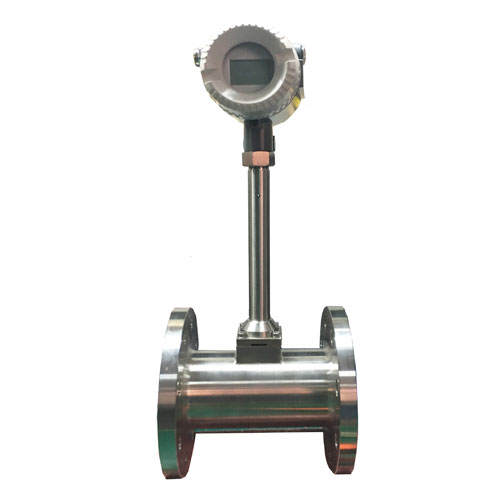EFM-TM series intelligent thermal gas mass flowmeter
The EFM-TM series thermal gas mass flowmeter is based on the principle that the rate of heat absorption is directly related to the mass flow rate. The sensor of this instrument consists of two reference level thermal resistors (platinum RTDs). One is the mass velocity sensor T1, and the other is the temperature sensor T2 that measures changes in gas temperature. When these two RTDs are placed in the measured gas, sensor T1 is heated to a constant temperature difference above the gas temperature, and the other sensor T2 is used to sense the temperature of the measured gas. As the gas mass flow rate increases, the airflow carries away more heat, causing the temperature of sensor T1 to decrease.
To maintain a constant temperature difference between T1 and T2, the heating power of T1 needs to be increased. According to the King's law of thermal effects. When moving gas molecules collide with a thermistor, they absorb and carry away heat. The larger the flow rate, the more molecules come into contact with the thermistor, and the more heat is absorbed. The heat absorption is related to the number of molecules, thermal properties, and flow characteristics of a certain gas. There is a definite mathematical relationship between heating power P, temperature difference △ T (T1-T2), and mass flow rate Q. P/△ T=K1+K2 f (Q) K3 K1, K2, K3 are constants related to the physical properties of gases. The EFM-TM series thermal gas mass flowmeter is different from other gas flowmeters in that it does not require pressure and temperature correction. It directly measures the mass flow rate of gas and is a true direct mass flowmeter. One sensor can achieve a range from extremely low to high.
Product features:
1. Measure gas mass flow rate without temperature or pressure compensation.
2.Large range ratio, measuring flow velocity range: 0.1Nm/s to 100Nm/s
3. No pressure loss, suitable for any shape of pipeline with known cross-sectional area.
4. Corrosion resistant sensor, suitable for measuring corrosive gases.
5. Expert algorithms for the full range range range are particularly suitable for large-diameter measurements, ensuring measurement accuracy and making them suitable for trade settlements.
6. Can perform excellent leak detection and equipment work for process pipelines.
7. The construction volume is extremely small, and due to the use of an inserted structure, it can be installed and maintained online.
8. Base type instruments can display locally and have alarm control.
Application areas:
9. Measurement of oxygen, nitrogen, hydrogen, air, and multi-component gases. (excluding acetylene gas).
10.Measurement of blast furnace gas and coke oven gas.
11. Measurement of flue gas.
12. Aeration and air measurement in biogas and water treatment.
13.Compressed air measurement.
14.Measurement of gas flow rates such as natural gas, liquefied gas, and flare gas.
15.Measurement of primary and secondary air flow in power plant blast furnaces.
16.Measurement of flow rate in underground ventilation or exhaust systems in mines.




